After several years of work and at least two Swiss military trials, Louis Schmeisser’s design of the Bergmann self-loading pistol was still not quite good enough to become a commercial success. Only a few pistols had achieved this goal, though, and the market was still wide open for anyone who could perfect their design.
The model 1894 Bergmann No.1 had made the pistol a straight blowback action, with a recoil spring located underneath the barrel. In 1896, Schmeisser changed this configuration, moving the spring into the back of the bolt assembly (where it would remain throughout all the rest of the Bergmann pistol variants). This was a more efficient use of space, as the forward position of the magazine defined the minimum length of the pistol. This space could be used to house the mainspring, encircling the firing pin (but not acting on it directly). This also allowed the firing pin to act as a mainspring guide, preventing it from kinking during assembly or disassembly. When looking at pistols, this change makes differentiation of the 1896 vs 1894 models simple – the later guns do not have a housing under the barrel to hold the spring.
The model 1896 pistol was made in three different calibers: 5mm, 6.5mm, and 8mm. This discussion will stick to the 5mm guns, which were designated No. 2 by Bergmann. These No. 2 pistols were produced at the same time as the 6.5mm (No. 3), and share a single block of serial numbers. Between the two models, approximately the first thousand guns made maintained the extractor-less design of the No. 1 – but it soon became apparent that this was a liability. While extraction was generally reliable, the lack of an extractor meant that there was no easy way to remove a case that did become stuck for any number of reasons. In addition, the extractor in a blowback pistol has a secondary function of controlling the position of an empty case to ensure it hits the ejector at the proper angle to eject cleanly. This was a flaw in the early Bergmanns, as cases could hit the ejector at odd angles and fail to clear the action, causing malfunctions (and consider the clearing process, given that without an extractor you cannot retract a partially fed round by pulling the bolt back).
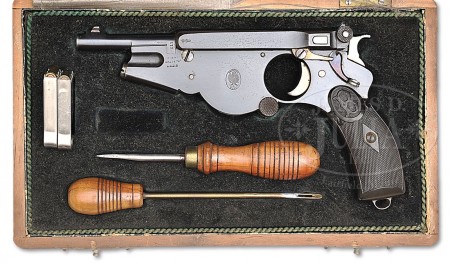
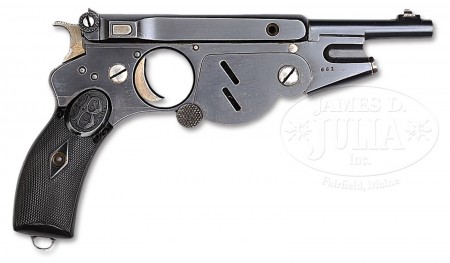
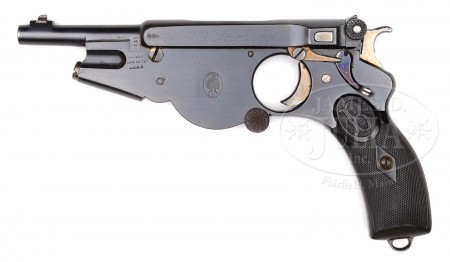
With all of this in mind, Schmeisser added an extractor to the 1896 Bergmann design after those first thousand of so guns. This of course also required a change in the ammunition to use a cartridge case with an extractor groove. That was simple enough, as all the rest of the geometry of the 5mm Bergmann case was retained, including the significant taper of the case (which was instrumental in allowing easy and reliable extraction, as the slightest rearward movement of the case in the chamber would remove all contact between case and barrel). In both the early and later versions, the 5mm Bergmann fired a 35 grain FMJ bullet at 580 feet/second. The ammunition was manufactured by DWM, and early examples used a cannelured bullet and full crimp while later production eliminated the cannelure and used a 3-point stab crimp. In DWM’s catalog, the cartridges were identified as #416 (early, no groove) and #416A (late, with groove).
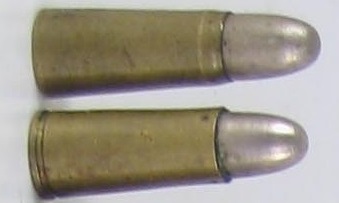
Ballistically, the 5mm Bergmann is one of the weakest cartridges produced aside from gallery or Flobert type rounds. It had about half of the velocity of the contemporary 5mm Clement, and about 60% as much muzzle energy as the .22 Short (26 ftlb). I still wouldn’t want to be shot by one, but it was clearly outclassed even in its own day. Sales reflected this, as it was less popular than the No.3 Bergmann (in 6.5mm). On the other hand, the options for a quality pocket semiauto were very limited in 1896, and the No. 2 was reasonably popular with between 1,500 and 2,000 being sold in Europe and beyond. Wilson is a bit contradictory in his assessment of the cartridge, claiming both that it has both “considerable penetration” and yet also a tendency to be insufficiently stabilized and to keyhole at 20 feet.
Loading the No.2 Bergmann was the same process as the No.1; the magazine was accessible through a pivoting cover plate on the right side of the pistol. It would hold 5 rounds of ammunition, typically carried as a single unit in a Mannlicher-type clip. A follower finger in the magazine (rotated out of the way when loading) would push the cartridges up, and allow the clip to fall free through the bottom of the magazine when empty.
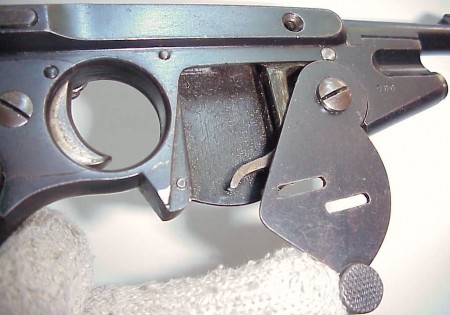
Ejection on the No.2 was vertical, out the top of the action. Unlike the larger versions of the 1896 design, the No.2 did not have a protective cover over the ejection port – probably because the pistol was too small for this to be conveniently made without being too flimsy. One other feature unique to the No. 2 was the option of a folding trigger. This was not an uncommon design element in period revolvers intended for pocket carry, but it was unique in selfloaders.
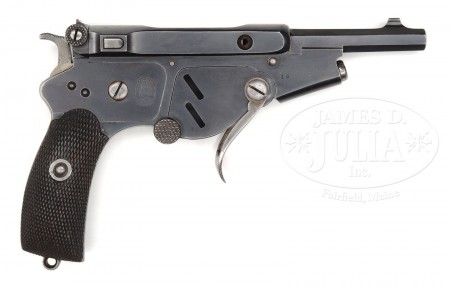
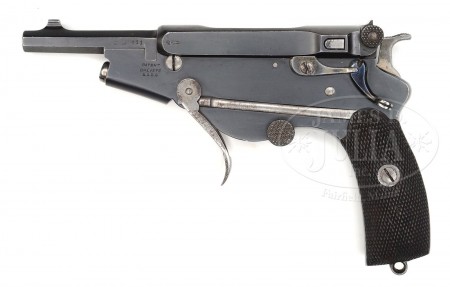
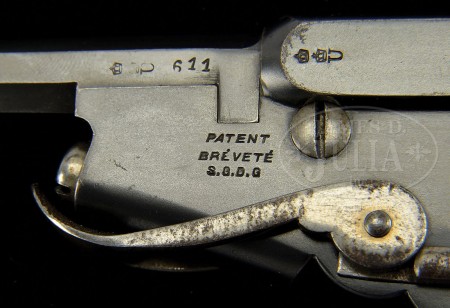
One other interesting feature of the 1896 Bergmanns is that their barrels are easily removable. In the above photo, you can see a screw above the trigger – this is what retains the barrel. Remove that screw and rotate the barrel 90 degrees (the barrel’s positioning lug is visible right above the patent text), and it comes off. This allows for easy cleaning, since access to the breech would otherwise require removing the bolt completely.
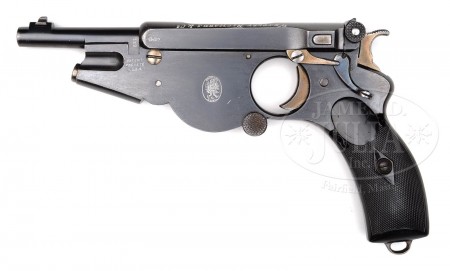
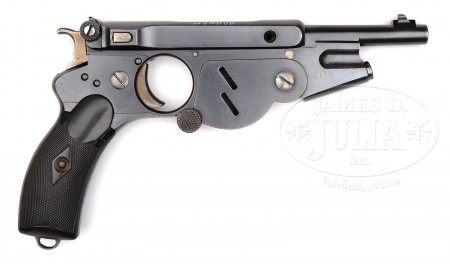
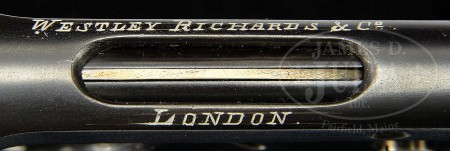
One final note – I have found photos of about a half dozen different No.2 Bergmann pistols (these three from Julia being the best quality photos), and every single one of them is marked “611” on the left side of the barrel. The actual serial numbers are on the right side, in front of the magazine. I have no idea what the 611 marking indicates, but a different number is used on other caliber 1896 pistols (the No.3 and No.4).
Technical Specs
Caliber: 5mm Bergmann
Bullet Weight: 35 grains
Muzzle Velocity: 580 fps (177 m/s)
Clip Capacity: 5 rounds
Overall Length: 11 in (280mm)
Barrel Length: varies, typically 3-3.5 in (75-90mm)
Weight: 36.3 oz (1.03kg)
Action: Straight blowback
References
Ezell, Edward C. Handguns of the World. Stackpole Books, New York, 1981.
Reinhart, Christian and am Rhyn, Michael. Fastfeuerwaffen II.
Wilson, R.K. Textbook of Automatic Pistols. Samworth, 1934 (reprinted by Wolfe Publishing, Prescott AZ, 1990).

Please show the magazine.. I have one and want to see if it’s the right one…